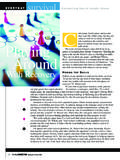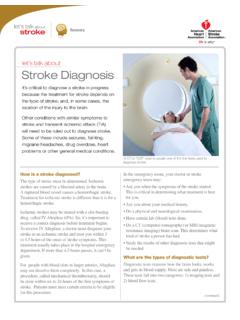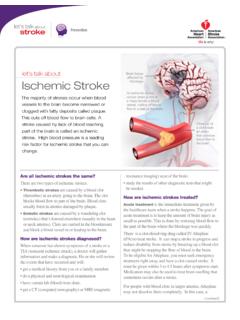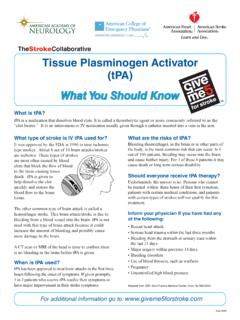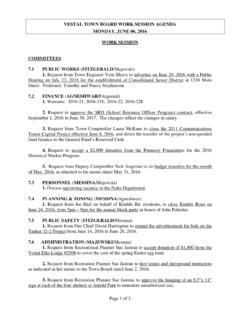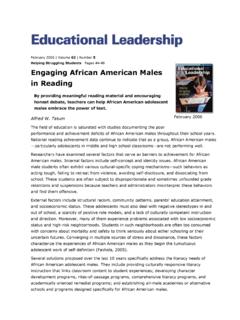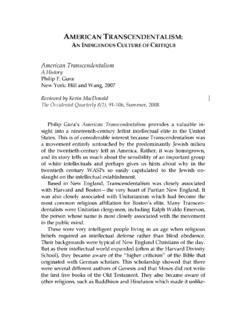Transcription of Successful Stroke Support - American Stroke …
1 Our guide to organizing Successful Stroke Support groupsSuccessfulStrokeSupportGroupsThe American Stroke association is fighting backagainst more than 50 years, the American HeartAssociation has funded research to discover newways to prevent and treat Stroke . We have alsodeveloped programs and patient and professionaleducation materials to raise public awareness aboutthis deadly disease. And, in 1998, we created theAmerican Stroke association as a division of theAmerican Heart association to intensify our effortson behalf of Stroke survivors and caregivers. Ouractivities include: Teaching families the warning signs of Stroke . Funding research to find new ways to preventstroke. Developing guidelines for physicians to treatstroke. Providing Stroke survivors and their families aplace to get answers after American Stroke association is a nationwidenetwork of Stroke survivors and caregivers sharinginformation, experience and Support with anyoneaffected by Stroke .
2 The association also includesdedicated professionals from many different medicaland research disciplines, all united to reducedisability and death from Stroke AssociationI. Why Start a Stroke Support Group?2 Living With Stroke : An Adjustment for the Family2 The Need for Peer Support , Hope andEncouragement3 Discovering the Value of Support4 Finding a Way To HelpII. How Are Stroke Support GroupsStarted?5 Setting Goals5 Getting Organized6 Finding Leaders and Facilitators7 Next Steps8 Finding Members9 Identifying a Meeting Place10 Acquiring Funds for Activities and OtherExpensesIII. How Do We Make Our Stroke Groupa Success?11 Developing Opportunities for Providing CaringSupport11 Making Careful Word Choices11 Establishing Group Guidelines12 Sharpening Your Listening SkillsIV.
3 What Type of Program ActivitiesShould We Plan?15 Staying Flexible15 Providing Structure for Meetings18 Deciding on Educational Programs19 Planning Social Activities and Entertainment19 Challenging Stroke Survivors20 Encouraging Group Discussion and PeerSupport20 Extending a Helping HandV. Will Our Stroke Group Continue ToGrow?22 Watching Group Members Come and Go22 Reaching Out to New Members23 Keeping Members Informed and Involved24 Finding the Secret Formula for SuccessVI. What Resources Are Available To HelpGroup Leaders?NationalGeneralRehabilitationCar egiverMental HealthFinancialEmploymentPatient RightsChildrenTable of Nationwide Network of Stroke Families HelpingStroke FamiliesThe American Stroke association , a division of theAmerican Heart association , is dedicated to helpingstroke survivors rebuild their lives.
4 The AmericanStroke association s Stroke Family Support Networkis a clearinghouse of information about strokeprevention, treatment, rehabilitation and recovery. It helps consumers learn about it is,where to go and what to expect after a Stroke . Over 1,800 Stroke groups and more than 36,000individuals throughout the United States are part of the Stroke Family Support Stroke association partners bring hopeand encouragement to the nearly 5 million strokesurvivors in the United States through a wide variety of peer Support and educational primary network programs, services andactivities are:800 Stroke Family Warmline Atoll-free information and referral line (1-888-4- Stroke [1-888-478-7653]) helps familiesconnect with other Stroke survivors and caregivers to get tips on daily living and other peer informationand Support .
5 Many of the Stroke Support Specialistsanswering the calls are also Stroke survivors Connection MagazineThis award-winning, 32-page, four-color, bimonthlyhealth education and outreach magazine extendsthe voice of the American Stroke association beyondthe network of Support groups. Information on strokeresources, caregiving, treatment advances, self-carestrategies, coping skills and real-life experienceshelp Stroke families and healthcare professionalsthroughout the 1-888-4- Stroke to receive a free copy or and sign up Stroke Group RegistryThe American Stroke association encourages thedevelopment of Stroke Support groups and providesresources for them. New Stroke groups across thecountry are registered, offering many benefits tostroke group leaders, including referrals of potentialnew members, and Stroke Connection Magazinefree for group Education Materials The American Stroke association offers magazines,fact sheets, brochures and other Stroke -relatedinformation through the Stroke Family Warmline, 1-888-4- Stroke (1-888-478-7653).
6 American Stroke us help others help themselves. Share the American Stroke association Stroke Family Warmline. American Stroke Association1 Living With Stroke : An Adjustment for theFamilyRelationships often change drastically aftersomeone has a Stroke . Physical difficulties and theemotional problems a Stroke can cause may quicklychange how Stroke survivors, their families andothers get along. Survivors often say friends and family members feeluncomfortable around them. He just is not himself, people say. Or, She is not like she used to be. Theold circle of family and friends begins to disappear,and survivors say it s hard to fit in like they a Stroke , even simple things like shopping,talking on the telephone or taking a walk may seemimpossible.
7 Talking or writing a letter may be toodifficult for a Stroke survivor who has problems usingor understanding language. Something as commonas going out to eat can be a major also may not be able to drive a car or usepublic transportation. Other day-to-day activities maybecome major obstacles to affects more than the survivor. Familymembers can also be confused, frustrated and feelisolated. Relationships may become strained,especially when a family member becomes acaregiver. And the caregivers may get angry or feelguilty about their feelings toward the survivor, who istaking so much of their time and energy. Individualfamily members may have to adjust how they feelabout themselves and others as responsibilities shiftand family relationships change.
8 There are no easy answers to the problems a strokecan create. These changes can negatively affect thesurvivor s rehabilitation and recovery after gettingout of the hospital. The longer a Stroke survivor isnot in society, the harder it is to rejoin society Need for Peer Support , Hope and EncouragementStroke survivors and their family caregivers needhelp adjusting to the changes in their lives. That swhy many Stroke survivors join Support similar problems helps survivors learn to livewith the changes. Stroke Support groups offersurvivors, their caregivers and other family memberschances to share concerns and Support each unite around their common experiences andfind positive solutions. Stroke Support groups allow Stroke survivors to helpthemselves and other survivors create meaningfullives after Stroke .
9 Coming together in an atmosphereof caring and cooperation, survivors, their familycaregivers and friends can forge a new sense ofcommunity. New goals and friendships are started,renewing hope and encouraging of empowerment is at the heart of a self-help or mutual-help group. It can motivate passive patients to become thriving survivors and createactive new roles for themselves. Stroke createsmany physical and emotional challenges. Eachstroke survivor faces a unique set of disabilities andlosses, and each copes with them in his or her ownway. However, the warmth, acceptance andemotional Support that a Stroke Support group offerscan often be the key to uncovering the hiddenstrengths in many Start a Stroke Support Group?2 IDealing With Your Isolation as a CaregiverPeer Support groups can be an important source of firsthandinformation.
10 They may also be crucial for the caregiver s ownwell-being. They Help you learn more about your loved one s condition,including treatments, prognosis and what the future may hold. Provide information about the best community resources(including day-care centers, assisted-living services andhome-care nursing), the most responsive professionals andthe latest equipment. Create networking connections so you ll have access to thebest care possible. Lessen the sense of stigma associated with being disabled. Give you an opportunity to joke and laugh about yourcircumstances with people who really understand and won tjudge you. Give you an opportunity to cry and complain without othersmaking you feel guilty about your own needs and pain. Give you a moment to focus on just you.



